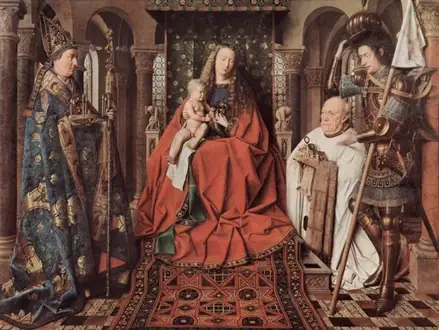Title of Artwork: “Madonna and Child with Canon Joris van der Paele”

Artwork by Jan Van Eyck
Year Created 1436
Summary of Madonna and Child with Canon Joris van der Paele
Dutch artist Jan van Eyck completed a large oil-on-oak panel painting of the Virgin and Child with Canon van der Paele in 1434–36. An apparition of saints can be seen in the painting’s donor, Joris van der Paele. Virgin Mary is depicted seated in the centre of the semicircular space, which most likely represents a church interior, with the Christ Child on her lap. She is flanked by St. Donatian and St. George, the donor’s name saint. Van der Paele ordered the panel to be used as an altarpiece. He was a wealthy clergyman from Bruges at the time, but he was in poor health and wanted to leave a lasting legacy.
All About Madonna and Child with Canon Joris van der Paele
The Latin inscriptions lining the borders of the imitation bronze frame, which is original, make it easy to identify the saints. Using historical records, it is possible to identify Van der Paele. The white surplice he’s wearing as he reads from an hour book is typical of a mediaeval canon’s finery. Presented to Mary by Saint George, his name saint, who holds aloft his metal helmet as a symbol of respect. Donatian stands to the left, dressed in brightly coloured vestments. Clothing, including exquisite depictions of furs, silks and brocade, and intricate and detailed religious iconography, are highlighted in the panel. Preludes to Jesus’ crucifixion and resurrection, as well as scenes from the Old Testament, can be found carved into the throne of the Virgin Mary. It is framed by a series of inscriptions that discuss the saints and include the signature of van Eyck.
The van der Paele panel has been called a “masterpiece of masterpieces” because it is widely regarded as one of van Eyck’s most fully realised and ambitious works.
His resemblance to Joris van der Paele as well as his paternal and maternal coats of arms (the Carlans’) at the corners of each frame help to identify him as Joris. When he returned to his hometown of Bruges in 1425, he was already a well-off man, having worked as a papal scribe in Rome during his early years. St. Donatian’s collegiate church appointed him to a canonry that provided him with income from the various parishes under his jurisdiction.
In 1431, van der Paele was unable to perform his duties as a canon due to illness, which prompted him to reflect on his role as a canon and his own mortality. It was in reaction to this that Van Eyck was given a commission and a church chaplaincy. Despite the artist’s fame and high demand, the commission took a long time to complete because of the size of the panel and because of the artist’s inability to complete it in the time frame he had originally planned.
After receiving the canon’s bequest, the church granted him daily masses, three votive masses per week, and the right to a requiem mass. In 1443, a second chaplaincy centred on prayers for his family and guaranteed that the requiem mass would end with readings of the Miserere mei and De profundis after his death.
Information Citations
En.wikipedia.org, https://en.wikipedia.org/.






















